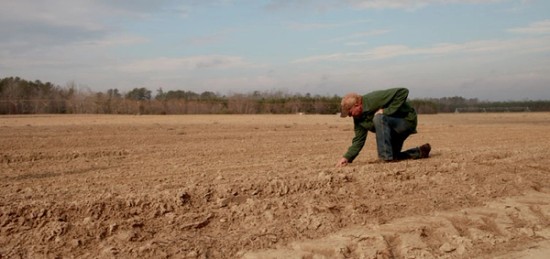The winter calm in peanut country is deceiving. It’s too soon to see farmers on their tractors moving through the fields, planting the spring crop. Acres of the cover crop of winter wheat rustle softly in the wind. The arms of irrigation systems stand stoic and still.
But the peanut farmers and farm workers are bustling. If you look closer, you can see the farmer and his longtime employee work on tractors in the barn, making repairs, cleaning and testing the machines to do the best job on this upcoming fresh, new crop. The farmer’s son is out by the irrigation system. He is doing a trial run of a new application that lets him control the machine through his smartphone. The farmer’s wife delivers a hearty breakfast of hay to their 20-head of beef cattle.
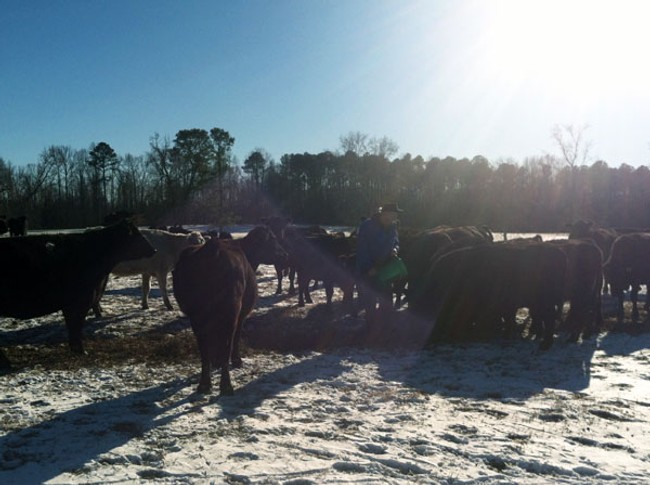
Taking care of cattle is a year-round job. Peanut farmer Billy Bain from Virginia feeds corn to his Angus on a crisp winter’s morning.
Later, they’ll start clearing the cover crop from the fields, which helps protect a harvested field from erosion and degradation. They’ll ready the fields, removing leftover stalks and any rocks or debris that may have found their way into the mix; trimming tree branches at the edges of the field that deprive the upcoming crop of sunshine.
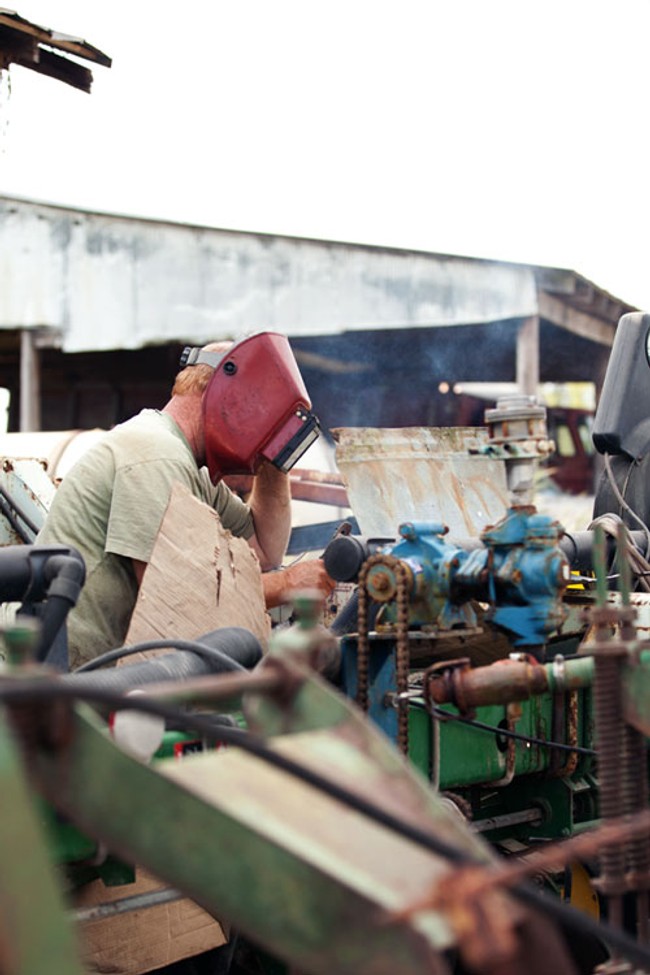
Preparing and repairing equipment for the planting season to come is a high priority during the winter months. Photo: Jennifer Warthan
Healthy plants come from healthy ground.
Maintaining the best soil depends on science and involves year-round work. When the weather warms slightly and the frozen ground no longer crunches under foot, farmers will test the health of the soil. Plantings and weather can dramatically change the makeup of soil in a field, even from acre to acre. Peanut grower Mike Jordan from Florida uses a type of soil sampling that’s becoming more common and helps him give each part of his fields that exact nutrition that it needs ahead of planting.
“Variable rate soil sampling helps ensure that the pH of the fields are level,” said Mike, who farms with his two brothers. “We take soil samples every two and a half acres that shows us the differences in pH. We can adjust how we treat the soil accordingly, adding lime, phosphate or potash directly where we need it.”
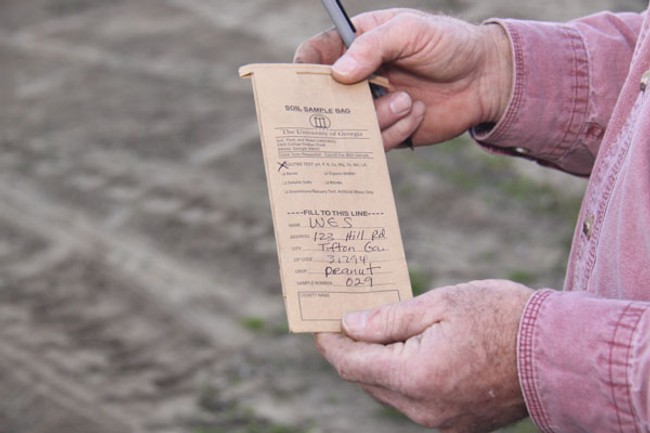
Georgia peanut farmer Wes Shannon gathers soil samples from his fields to make sure the upcoming crop is planted in healthy, nutrient-rich soil. Photo: Joy Crosby, Georgia Peanut Commission
Fittingly, the three Jordan brothers farm together in the three corners—where Florida, Georgia and Alabama meet. The family comes from a long line of farmers and Mike has seen use of technology like variable rate sampling benefit growers, crops and the environment. “It used to be that you would get three to five soil samples from a field and you might end up using more inputs than you needed,” he said. “Now it can be customized and it saves resources. This is the fourth or fifth year we’ve used variable rate soil sampling and it’s bringing up the yields on all of our fields.”
While farmers have a good idea of which crops they’ll plant in the coming season, how much and what type depends on a number of factors. Peanut farmer Scott Nolen from Gaines County, Texas said, “We decide how many acres of peanuts to plant based on how much winter moisture is available, what cotton prices are and peanut contracts that have been offered.” Scott, who also raises cattle and grows cotton, winter wheat, grain sorghum and pecans, will probably plan to plant a bit more peanuts this year than he did last year. “We’ve been growing Spanish peanuts because that’s what shellers want. Spanish have a shorter growing season so we don’t have to worry about freezing and we can plant a little later if needed.”
Making balanced planting decisions is like walking a tightrope.
Mike of Florida said, “We plant to the markets but we never put all our eggs in one basket so to speak. We also don’t want to mess up the balance of our rotation by planting too much of a single crop.”
Farmers who keep good crop rotation plans rather than planting the same or similar crops back to back usually see improved yields, which means that they produce more high-quality peanuts for you and me to eat. Lifelong peanut grower Billy Bain from Dinwiddie, Virginia, who also raises cattle, says he usually waits three to four seasons between planting peanuts or soybeans in the same field and rotates other crops like cotton, corn and wheat in between. Planting a variety of crops like these on the same field provides some natural protection against disease and pests. Peanuts are well known for adding nitrogen to the soil too, which is a beneficial nutrient for the next crop that’s planted.
Work is going on indoors during the cold months too.
Industry meetings, education sessions and certifications are in full swing, said Billy. “Farmers must be certified to use certain products that help protect the quality of the crops,” he said. “This is the time of year that we complete annual trainings to earn continuing education credits to keep those licenses. It’s something we’re very serious about.” A third generation farmer, Billy has farmed professionally for 45 years and still lives in his childhood home in southeastern Virginia. Part of what that experience and history has shown him is the importance of staying informed and evolving. At industry meetings, “we find out what peanut researchers are doing to help make our operations more efficient and improve the crops, like new varieties that help keep the plants healthy with fewer inputs,” said Billy.
Back on the field…
As the winter sun sets just a few moments later than it did the day before, the farmers get closer and closer to putting their knowledge and preparations to work to grow the best peanuts possible for us all.
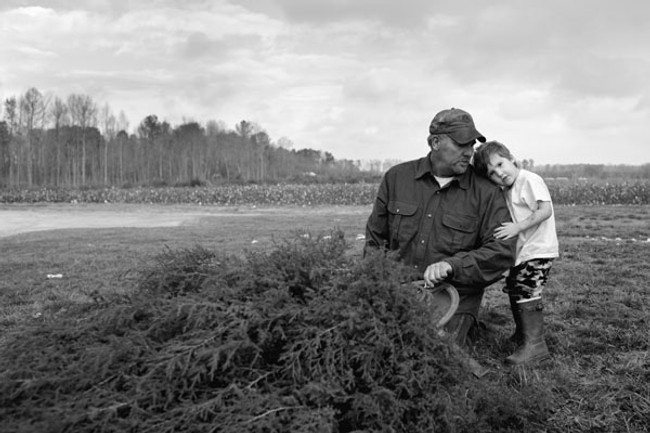
Photo: Jennifer Warthan
